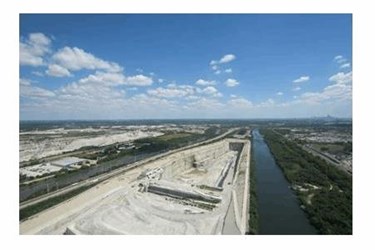Crowds Flock To MWRD's Stunning View Of McCook Reservoir

Register for your free tour and see how the MWRD works to prevent flooding and water pollution
Visitors began pouring in to see the MWRD's McCook Reservoir and Mainstream Pumping Station on Aug. 6 to learn how the MWRD adjusts to meet this century's challenges of pouring rains that formerly overwhelmed local sewer systems and polluted waterways and flooded communities.
The MWRD, known for reversing the flow of the Chicago River over a century ago, manages the world's largest used water reclamation plant and operates the country's largest public works project for pollution and flood control, known as the Thornton Composite Reservoir. There will soon be an even larger facility when Phase 1 of the McCook Reservoir comes online in December.
Completed in two phases, as part of the MWRD's famed Tunnel and Reservoir Plan (TARP), the McCook Reservoir will have a total capacity of 10 billion gallons; the first phase will be finished this year and will provide 3.5 billion gallons of storage. Phase 2 is scheduled to be completed in 2029 and provide 6.5 billion gallons of storage. The McCook Reservoir will provide an average of $143M per year in flood damage reduction benefits to 3.1 million people in Chicago and 36 other communities.
"We are excited to be closing in on the completion of phase one of the McCook Reservoir," said MWRD President Mariyana Spyropoulos, who attended the first day of tours at McCook. "We thank our partners with the U.S. Army Corps of Engineers, our congressional leaders, contractors and neighboring communities for helping us accomplish this giant feat."
TARP, also known as the "Deep Tunnel," is the country's largest public works project for pollution and flood control being emulated all around the world. TARP covers a 375-mile area that includes Chicago and 51 suburbs relying on a combined collection system. The 109-mile network of tunnel systems, which capture 2.3 billion gallons of water 150 to 300 feet below ground, was completed in 2006 followed by the Majewski Reservoir in 1998 and the Thornton Reservoir in 2015.
At McCook, a double row grout curtain and slurry wall were installed around the entire reservoir perimeter to seal the ground and connect to an impermeable natural layer of shale that exists approximately 325 feet below ground, preventing water from leaving through the bottom of the reservoir. In order to dewater the reservoir to the Mainstream Pumping Station, a series of distribution tunnels were constructed between the pumping station and the reservoir. The existing Mainstream and Des Plaines Tunnels were extended to connect to the reservoir and include gate shafts with steel roller gates to isolate the tunnels from the reservoirs when needed. Inside the reservoir, inlet/outlet structures facilitate flow and protect the reservoir floor from the water's energy, and an aeration system is being installed to oxygenate the water surface.
As part of the tours, the MWRD welcomes visitors to the Mainstream Pumping Station, 6100 River Rd., in Hodgkins, IL, before bussing them to the east rim of the reservoir for guided tours. Visitors are given a complete overview of the TARP system and how it functions to improve local water quality and mitigate flooding throughout Cook County. Visitors can view interactive displays and watch videos of TARP construction at the pumping station.
"These tours are integral to our mission of transforming water and promoting education, transparency and innovation in stormwater engineering," said MWRD Commissioner and Chairman of Finance Frank Avila. "By opening our doors to the public, we are encouraging the public to learn more about the challenges of managing our water and to take ownership of protecting their own water environment because we cannot accomplish this herculean task alone."
Remaining tours are scheduled for Aug. 27, Sept. 17 and 24, Oct. 1 and 15 between 9 a.m. to 2 p.m. Each tour takes approximately two hours. Visitors must wear sturdy footwear; no sandals. To reserve space on an upcoming tour, call 312-751-6632 or email tours@mwrd.org.
Views from the first day of tours at McCook Reservoir capture the interest of all ages. To create the reservoir, over 9.4 million cubic yards of overburden was removed from the site to expose the top of the limestone rock. Visitors can take home a part of that 400 million year old limestone and perhaps find a fossil.
About The Metropolitan Water Reclamation District of Greater Chicago
Established in 1889, the MWRD is an award-winning, special purpose government agency responsible for wastewater treatment and stormwater management in Cook County, Illinois. For more information, visit www.mwrd.org.
Source: The Metropolitan Water Reclamation District of Greater Chicago (MWRD)
